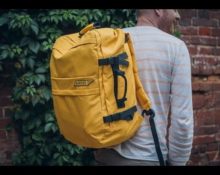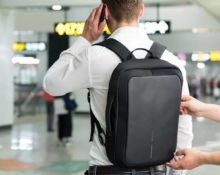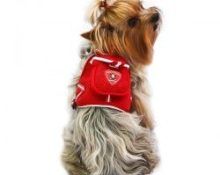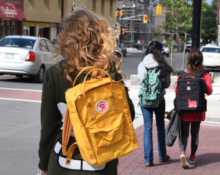Flood, earthquake, mass attack, critical release of harmful substances into the environment, terrorist attack - situations that may require unscheduled evacuation.
After such an emergency leaving one’s home, a person does not always receive immediate access to a bomb shelter or other socially significant government facility. Sometimes he has to reach it. How to survive on the way to safe territory? Use the contents of the survivalist backpack.
What is a survivalist backpack?
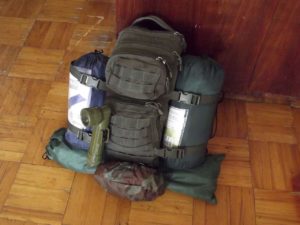 This is a voluminous shoulder bag, the contents of which are enough for the autonomous existence of 1 person for several days. This feature makes it similar to an alarm suitcase. However, the latter is much more compact and is designed for only 1.5-3 days. well and A properly assembled survival backpack can ideally help you survive for a whole week. If it is possible to replenish food supplies - 2-3 weeks.
This is a voluminous shoulder bag, the contents of which are enough for the autonomous existence of 1 person for several days. This feature makes it similar to an alarm suitcase. However, the latter is much more compact and is designed for only 1.5-3 days. well and A properly assembled survival backpack can ideally help you survive for a whole week. If it is possible to replenish food supplies - 2-3 weeks.
Important! A real survivalist's backpack weighs about 20 kg - an unbearable burden for many people.They won’t be able to go far with it; they’ll have to quickly part with important things along the way. To prevent this from happening, it makes sense to initially pack a bag for 3 days, not 7.
What's included in this backpack? Equipment
It is based on objects aimed at satisfying the most basic human needs. This category includes:
- dream;
- food;
- clean water;
- health and safety.
To meet these needs you will need (minimum base):
- water, a reliable container for it, cleaners and disinfectants (minimum - iodine, preferably tablets);
- matches, lighter;
- knife;
- food;
- first aid kit;
- rain cover;
- 2 needles, several buttons, thread (2 skeins of different thicknesses);
- universal glue.
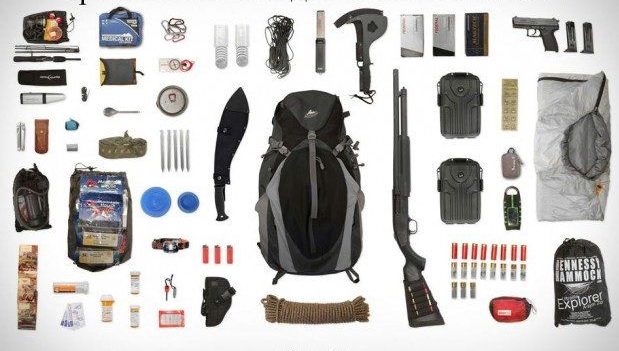
Addition to the database:
- axe;
- map, compass;
- spoon, mug;
- change of clothes;
- rug;
- sleeping bag, tent;
- hygiene products (not wet wipes, but soap);
- tools and materials for tent repair;
- hat (cap);
- flashlight;
- folding bucket;
- rope;
- shoes;
- batteries;
- walkie-talkie
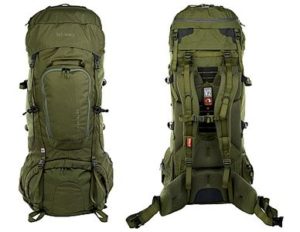 Cooking utensils are not included in the recommended lists. Some prefer to expand the list with a boiler and burner, others adapt cans to the process, and others learn the secrets of cooking food without utensils.
Cooking utensils are not included in the recommended lists. Some prefer to expand the list with a boiler and burner, others adapt cans to the process, and others learn the secrets of cooking food without utensils.
From the latter point of view, it is easiest for real hunters to survive, located in familiar territory. It is easy for them to get food and does not need to complicate the cooking process. For example, they will be able to kill game birds, pluck it, cover it with clay and bake it in coals.
When assembling a backpack, you should take into account the high probability that hunting will be impossible. Just like starting a fire. Therefore, you need to take with you products that can be consumed without heat treatment.. These include cereals, but not all. Buckwheat can definitely be consumed raw, but do it carefully. The grains swell greatly in the stomach, you need to eat very little and drink plenty.
Important! Cereals have an expiration date. To increase it, pierce the grains in the oven at 200–220 degrees.
What other food should you take with you:
- freeze-dried food in packages (specialized food for extreme tourists and survivalists);
- canned food (only real Gost stew, no stew products - the share of real meat in the latter is minimal);
- lollipops;
- dried meat.
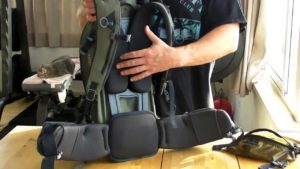 Be sure to take tea with you. A hot drink is great for keeping you warm. But you should avoid instant noodles, which are sometimes recommended to take with you because of their ability to swell in the stomach.. Well, we must admit that any food spoils quickly, and therefore it makes sense to take care of preservation.
Be sure to take tea with you. A hot drink is great for keeping you warm. But you should avoid instant noodles, which are sometimes recommended to take with you because of their ability to swell in the stomach.. Well, we must admit that any food spoils quickly, and therefore it makes sense to take care of preservation.
The issue is resolved with the help of salt, vinegar, real seasonings (not universal mixtures). However, you cannot carry them with you in sufficient quantities, because experienced survivalists not only assemble a backpack, but also make caches. This approach is especially recommended for hunters and those who plan to obtain food on their own. Devices that help get food are also bookmarked: snares, bows, fishing rods, traps. The use of some is prohibited by law today, but during global emergencies, legal issues fade into the background.
Important! Canned fish is not as nutritious as meat. The latter should be given preference.
Tips for choosing clothes and shoes:
- underwear made from 100% natural fabrics, socks with added synthetics (for durability);
- for the off-season and winter - thermal underwear;
- fleece suits are warm and breathable, but get wet easily (It should not be used as main clothing, but for overnight stays and relaxation it is an ideal option.);
- the jacket must have a hood (for autumn and winter models, heat-reflecting inserts, cuffs on the sleeves and hem, and drawstrings on the hood are required);
- In extreme cold weather, clothing made of wool, worn in 4–5 layers, can save you (things should not be thick or tight-fitting);
- pre-worn shoes will not allow you to go far;
- wet feet are a source of fungus, kidney and bone diseases, colds and pulmonary diseases (shoes must ensure maximum dryness);
- hands should be protected no worse than feet (1 warm pair, 1 rubberized pair).
Important! Clothes weigh a lot, especially wool and fleece. It makes sense to pack 2 backpacks: 1 for winter, 1 for summer. In the latter, the number of spare wardrobe items should be kept to a minimum. When collecting, you should also use vacuum bags. They significantly reduce the volume of things and prevent them from getting wet.
When collecting, you should also take into account the drying speed of various materials. If the underwear is made of synthetics and the trousers are made of natural fabric, then they will dry for different times.. At the same time, panties, which due to the properties of the fabric become dry faster, will absorb moisture from the pants. This can cause hypothermia.
Possible list of clothes:
- 2 pairs of socks (woolen);
- 2 changes of linen;
- 2 shirts or T-shirts (1 with long sleeves, the second with short sleeves);
- thermal underwear;
- trousers (not jeans);
- a cap;
- sweater or fleece jacket;
- jacket;
- gloves.
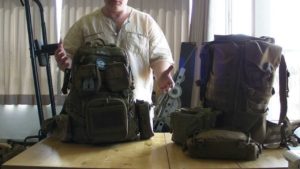 The list is very wide. If you stick to it, the assembled survivalist backpack will weigh 20 kilograms. You can reduce the weight a little by turning to clothes for trekking and hiking. Among these products you can find natural down jackets. Down compresses much better than synthetics and weighs less.
The list is very wide. If you stick to it, the assembled survivalist backpack will weigh 20 kilograms. You can reduce the weight a little by turning to clothes for trekking and hiking. Among these products you can find natural down jackets. Down compresses much better than synthetics and weighs less.
However, in heavy rain, a down jacket, sleeping bag or jacket with real down is a source of additional problems. The fluff must be dried, but no one guarantees that a survivalist will have such an opportunity. Natural wool also does not dry quickly, but it is less sensitive to constant dampness. Therefore, a wool sweater is the best solution for some areas.
How to pack such a backpack correctly?
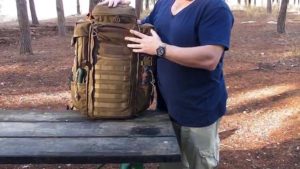 First, you should know your own weight. A fully equipped backpack should be 70% lighter than the male owner. A woman will be able to carry even less, or will move unacceptably slowly or will completely overstrain herself.
First, you should know your own weight. A fully equipped backpack should be 70% lighter than the male owner. A woman will be able to carry even less, or will move unacceptably slowly or will completely overstrain herself.
Second rule: the heaviest things are placed not at the bottom, but as close to the back of the backpack as possible. This approach will reduce the stress on your shoulders. The following things go to the bottom:
- sleeping bag;
- sleepwear;
- awning;
- mat for a sleeping bag or tent.
Having laid out the bottom, proceed to filling the back area. Objects are placed according to the principle from the heaviest and largest to the lightest and most compact. Often the heaviest items are tools (an axe) and food.
The middle section, coming after the vertical zone at the spine, is suitable for long items: shoes, raincoats, dishes. Well, the essential items are placed closest to the locks:
 knife;
knife;- first aid kit;
- flashlight;
- map;
- radio.
The last point is often replaced by a walkie-talkie, and the map by an electronic guide. However, the former has a limited coverage area. In addition, there are no guarantees that you will be able to get in touch with reliable people. Well, an electronic guide will not help in the forest. Against its background, an atlas or a map are universal assistants.
Important! Cereal bags may burst under pressure. It is recommended to pour cereals into plastic bottles.
If the situation happens in winter, insulating clothing should be placed in the top layer and closer to the lock. When camping in cold weather, the first thing you should do is not light a fire or put up a tent, but insulate yourself.


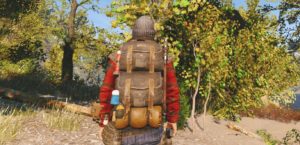 knife;
knife; 0
0
